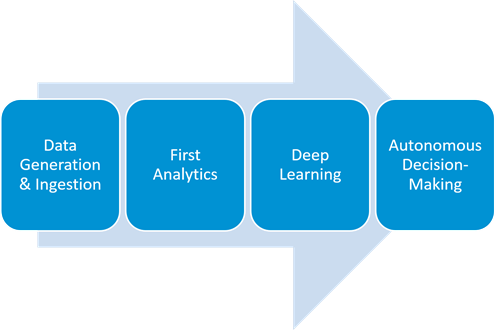
Maturity levels are important because they provide organizations with a goal-oriented path, so they can measure progress and celebrate small successes on their way to a greater goal. They are important because, as experience shows, it is best for organizations to progress through consecutive maturity levels rather than to simply try to swallow a super-complex project at once. Violent and ambitious jumps in maturity typically fail due to organizational change resistance, immature operational procedures, and deficient governance practices. It is better to have a solid hand on a maturity level before adventuring into the next one.
Here at the 4 maturity levels of IoT, and what they mean for organizations:
Level 1: Data Generation and Ingestion
What is it about: In level 1, organizations begin projects to generate and collect IoT data. This involves coupling their services or products with devices that capture data and gateways to transmit that data, implementing data ingestion pipelines to absorb that data, and storing that data for later use.
What it means: at this point, companies are finally in a position to generate data and collect it. Data generation is the key building block of IoT, and the first maturity level is aimed at getting your hands on data. Typically, the hardest part are the devices themselves, how to securely capture and transmit the data, how to manage those devices in the field, solve connectivity issues, and building a pipeline that scales to serve many devices.
Level 2: First Analytics
What is it about: once armed with data, companies will typically try to derive some value out of it. These are initially ad-hoc, exploratory efforts. Some companies might already have a developed concept about how they will use the data, while others will need to embark in exploring the data to find useful surprises. For example, data analysts / scientists will start connecting to the data with mainstream tools like Excel and PowerBI and start exploring.
What it means: Companies might be able to start extracting value from the data generated. This will mostly be manual efforts done by functional experts or data analysts. At this stage, the organization starts to derive initial value from the data.
Level 3: Deep Learning
What is it about: the organization recognizes that the data is much more valuable and large than manual analysis permits, and starts investing in technology that can automatically extract insights from the data. These are typically investments in deep learning, machine learning or streaming analytics. Whereas the value of the data in Level 2 was extracted from the manual work of highly-skilled experts, the value of the data in Level 3 is extracted automatically from sophisticated algorithms, statiscal models and stochastic process modeling.
What it means: the organization is able to scale the value of its data, as it is not dependent anymore on the manual work of data analysts. More data can be analyzed in many more different ways, in less time. The insights gained might be more profound, due to the sophistication of the analysis, which can be applied to gigantic data sets with ease.
Level 4: Autonomous Decision Making
What is it about: the deep learning and analytical models, along with their accuracy and reliability, are solid upon exiting Level 3. The organization is now in a position to trust these models to make automated decisions. In Level 3, the insights derived from deep learning are mostly used as input for pattern analysis, reporting dashboards and management decision-making. In Level 4, the output of deep learning is used to trigger autonomous operational actions.
What it means: in Level 4, the deep learning engine of the organization is integrated with its operational systems. The deep learning engine will trigger actions in the ERP (i.e: automatic orders to replenish inventory), LoB systems (remote control of field devices via intelligent bi-directional communication), the CRM (triggering personalized sales and marketing actions based on individual customer behavior), or any other system that interacts with customers, suppliers or internal staff. These actions will require no human intervention, or at least, require minimal human supervision or approvals to be executed.
Do you need to go all the way up to Level 4?
Not necessarily. How far you need to invest into the maturity of your IoT stack is dependent on the business case for such an investment. The true impact of IoT, and what business value it might bring, is very hard to gauge at Day 0. It is best to start with smaller steps by developing innovative business models, rapidly prototyping them, and making smaller investments to explore if an IoT-powered business model is viable or not. Make larger commitments only as steps from previous successes. This allows you to fail fast with minimal pain if your proposed business model turns out to be wrong, adapt the model as you learn through iterations, and allows your team to celebrate smaller successes on your IoT journey.
Subscribe to our RSS feed